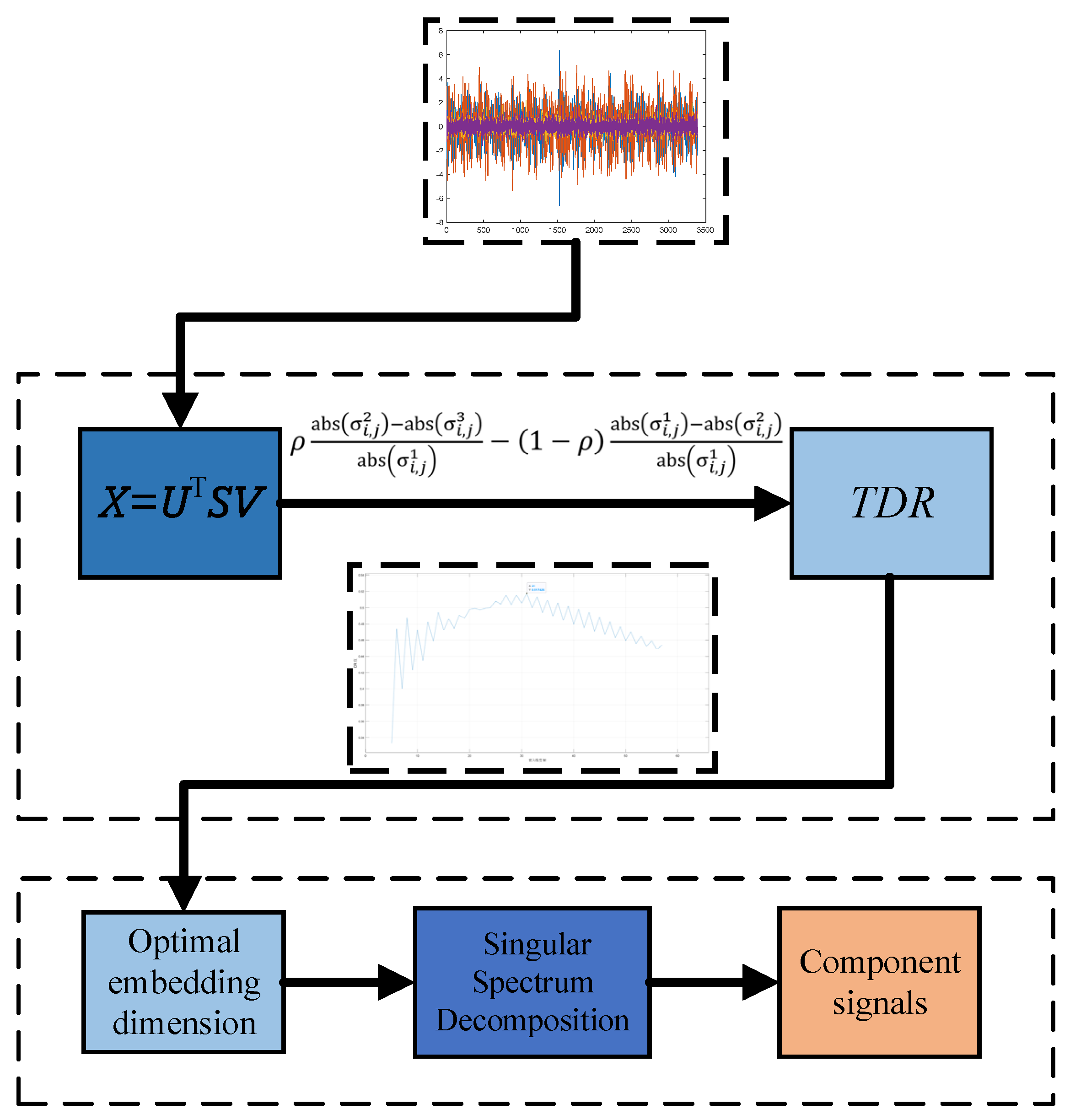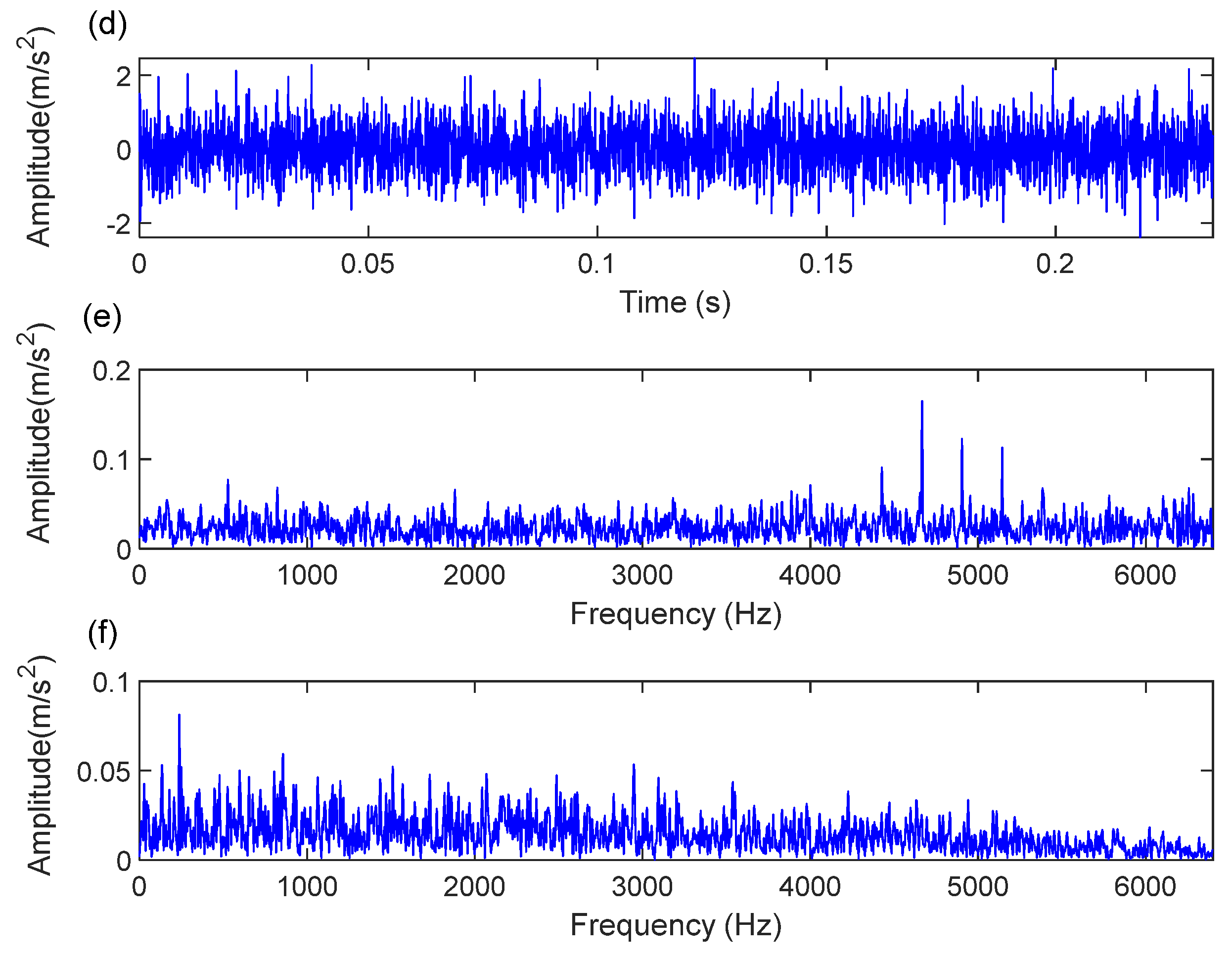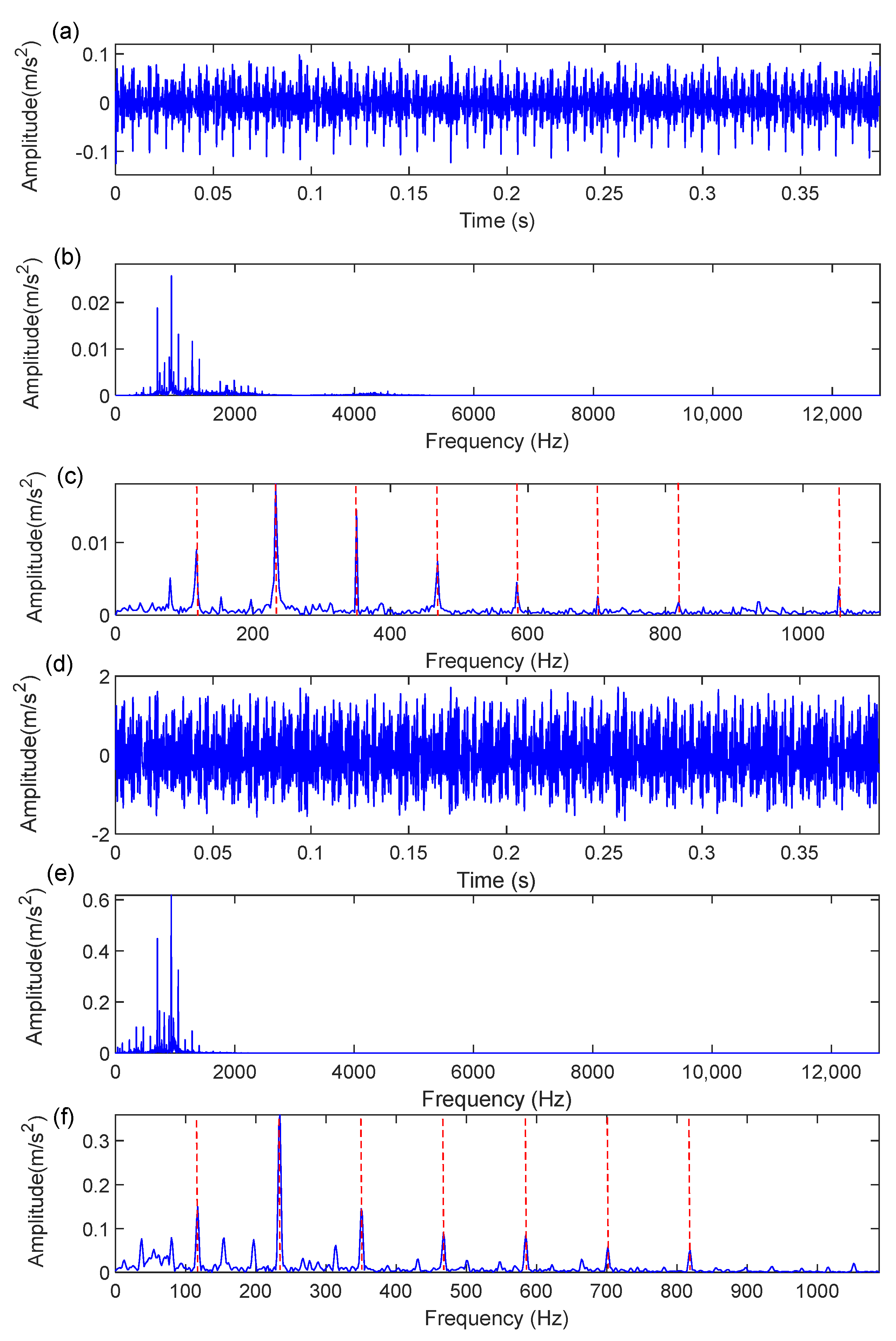1. Introduction
With the continuous development of industrial automation and intelligent production, condition monitoring and fault diagnosis have become essential means for ensuring the safe and efficient operation of industrial systems. Efficient decomposition and analysis are crucial for the fault diagnosis of mechanical equipment [
1,
2,
3]. In particular, employing multichannel signal acquisition allows for the synchronous capture of vibration signals in multiple directions and locations. It provides a more comprehensive reflection of the equipment’s dynamic characteristics and helps to identify potential faults. However, due to the complex and variable nature of such signals, existing decomposition algorithms struggle to effectively address this challenge.
In recent years, numerous researchers have sought to improve methods for rolling bearing fault diagnosis. Yin et al. [
4] studied a fault diagnosis approach that combines Fast Fourier Transform (FFT) and Convolutional Neural Networks, which significantly improves its diagnostic accuracy while reducing its dependence on expert experience. However, its feature extraction capabilities are limited, and high-quality training data are required. Wang et al. [
5] introduced a bearing fault diagnosis method leveraging deep feature enhancement combined with reinforcement learning to improve diagnostic robustness and capture global information. However, the model is complex, and its interpretability of features is limited. Chen et al. [
6] successfully identified weak transient fault features under strong noise environments by combining the squared envelope spectrum and successive variational mode decomposition, though the computational cost of this was high. Fei et al. [
7] proposed a hierarchical decision fusion diagnosis method aimed at improving diagnostic accuracy, which can accurately detect faults under different working conditions, locate faults, and estimate fault severity. However, this method has the disadvantage of being complex in model parameter tuning. Xu et al. [
8] developed a diagnostic approach that integrates Singular Value Decomposition with the squared envelope spectrum, aiming to address the challenge of weak early defect signals being prone to noise interference and thereby effectively identify early fault types, although its noise suppression capability remains limited. To address compound faults caused by bearings and other components, Fan et al. [
9] presented a method based on information fusion, Empirical Mode Decomposition (EMD), and polar coordinate adaptive distribution images for detecting the compound faults of rolling bearings and rotors. This method, when dealing with complex compound faults, may require specific handling for each type of fault feature, and its applicability could be limited if confronted with unknown or diverse types of faults. Gao et al. [
10] proposed a fault classification method that utilizes Complete Ensemble Empirical Mode Decomposition with Adaptive Noise (CEEMDAN), Fuzzy Measure Entropy (FME), and a Particle Swarm Optimized Probabilistic Neural Network (PSO-PNN) for improved fault detection. This method decomposes noise components from the signal and extracts features using fuzzy measure entropy, followed by classification through an optimized probabilistic neural network, but it has high computational costs. Wu et al. [
11] addressed the insufficient feature extraction under complex working conditions and the low diagnostic accuracy in small datasets by proposing a fault diagnosis method based on MTF-CBAM-IResNet, significantly improving diagnostic accuracy. By introducing a Multi-scale Temporal Feature (MTF) and Convolutional Block Attention Module (CBAM), the feature extraction effectiveness is enhanced, and an improved residual network (IResNet) is utilized for more accurate classification. However, the adaptability and generalizability of this method to other fault scenarios or significantly different data distributions still need verification. Jiang et al. [
12] proposed a dual-channel CNN rolling bearing fault diagnosis method, which combines Sparrow Search Algorithm optimized Variational Mode Decomposition (SSA-VMD) and Symmetric Dot Pattern (SDP) to address the nonlinearity, nonstationarity, and limited feature extraction performance of single-channel CNNs in rolling bearing fault signals. However, the computational complexity of this method remains high, and its robustness is limited. To extract and fuse complementary fault features from multi-sensor data, Wang et al. [
13] proposed a multi-level feature tensor fusion network for bearing fault diagnosis, effectively improving fault diagnosis performance, though there is a risk of overfitting.
In summary, the above methods still face the issues of insufficient resolution, sensitivity to noise, and a high computational complexity when handling multichannel signals. Tensor decomposition, as an effective multidimensional data analysis tool, has increasingly become a research focus in the signal processing field due to its capability to simultaneously handle multichannel and multidimensional signal data. Over the years, various advancements in tensor decomposition techniques have been proposed to address various challenges. Kilmer et al. [
14] proposed a tensor–tensor product and tensor–SVD. Wang et al. [
15] proposed a truncated higher-order tensor singular value decomposition to extract fault features, aiming at the problem of the truncation parameters of higher-order tensor singular value decomposition not being determined. Lu et al. [
16] developed a tensor robust principal component (TRPCA) approach. Huang et al. [
17,
18] presented a flexible tensor multiplication and two kinds of tensor singular value decomposition. These advancements have enriched the theoretical framework of tensor decomposition and contributed to its ongoing development. Particularly, the first kind of tensor decomposition method can deeply reveal the intrinsic structure and multidimensional characteristics of signals, providing new insights for the decomposition and feature extraction of complex signals.
However, existing tensor decomposition methods still have shortcomings in practical applications. Firstly, the choice of embedding dimensions significantly affects the signal decomposition effect; fixed embedding dimensions struggle to adapt to the complex dynamic characteristics of different signals, potentially leading to insufficient information capture or excessive noise introduction. Secondly, existing tensor decomposition algorithms face a trade-off between computational efficiency and decomposition accuracy when dealing with large-scale data, necessitating improvements in computational performance while ensuring decomposition effectiveness. To address these issues, this study investigates a novel dual-channel signal decomposition algorithm based on flexible tensor decomposition combined with adaptive dimension selection. By introducing a Tensor Dynamic Range (TDR) metric, the embedding dimensions are adaptively selected to ensure that the embedding dimensions automatically adjust with changes in the signal characteristics, thereby improving the accuracy of signal decomposition. Furthermore, this study aims to enhance the efficiency and precision of multichannel signal decomposition through improved tensor decomposition methods. The main contributions of this work are as follows:
A trajectory tensor embedding dimension adaptive selection algorithm is proposed, allowing for the dynamic adjustment of embedding dimensions based on signal component characteristics.
Efficient and accurate dual-channel signal decomposition is realized through flexible tensor decomposition, enhancing the overall performance of signal analysis.
The remainder of this paper is organized as follows:
Section 1 introduces the adaptive embedding dimension selection method and its implementation steps;
Section 2 elaborates on the flexible tensor decomposition principle and the new algorithm;
Section 3 presents the experimental design and result analysis for the proposed algorithm in dual-channel signals, verifying the effectiveness of the proposed method; and
Section 4 provides the conclusions.
Through this research, we aim to provide an efficient, robust, and adaptive approach for dual-channel signal decomposition and analysis, advancing the application and development of advanced signal processing techniques in areas such as mechanical fault diagnosis.
3. Flexible Tensor Singular Spectrum Decomposition
Tensor decomposition is an essential tool in multidimensional data analysis, used to decompose high-order tensors (multi-dimensional arrays) into combinations of simpler, structured lower-order tensors. Tensor decomposition has broad applications in various fields, including signal processing, machine learning, image analysis, and natural language processing, and demonstrates significant advantages, especially when handling multichannel and multidimensional signals.
Traditional tensor decomposition, such as CP decomposition and Tucker decomposition based on
n-mode products, suffer from inherent issues like non-unique rank and a non-pseudo-diagonal core tensor. Additionally, a T-T product [
20] can only be used for multiplication between tensors of the same order, greatly limiting the applicability of tensor singular value decomposition algorithms based on the T-T product. Flexible tensor products are one of the latest advancements in tensor decomposition theory [
18], and can be represented as follows:
where
p and
q represent the respective orders for the first and second tensors. Here, the symbol ’1’ denotes the forward order, i.e., the sequence of tensor modes follows the forward index, while ’2’ indicates the reverse order, following the reverse index. The parameter
o, a positive integer, indicates the order for the multiplier during the tensor product, with an allowable range of
. This flexibility provides more computational possibilities for tensor multiplication, making it adaptable to various application scenarios. To clearly denote the different forms of flexible tensor products, ref. [
18] described it as an “
o-order (
p,
q)-mode product.” This terminology provides a straightforward way to identify the particular type of tensor multiplication. Based on the flexible tensor product, the first kind of flexible tensor singular value decomposition can be derived as follows:
where
and
are orthogonal singular tensors, and
is the core tensor. The first kind of flexible tensor singular value decomposition (1K-FTSVD) for a third-order tensor
is illustrated in
Figure 2.
As observed in
Figure 2, it is evident that the 1K-FTSVD method breaks down third-order tensors into the following three constituent tensors:
,
and
. The left singular tensor
and the right singular tensor
are both of the second order. Furthermore, 1K-FTSVD guarantees a unique decomposition result and maintains a simple computation process. Based on the principle of 1K-FTSVD, an adaptive embedding Flexible Tensor Singular Spectrum Decomposition (FTSSD) algorithm is constructed.
For multichannel signals, tensorization is performed to map the time series of
k channels with
N sampling points into a third-order tensor space, in order to capture the high-dimensional characteristics of the signal. Each forward slice of the third-order tensors
corresponds to a trajectory matrix
for the following:
where
,
, and
is the embedding dimension.
The selection of the embedding dimension is adaptively determined using the TDR formula. Subsequently, the resulting trajectory tensor undergoes tensor singular value decomposition, as described in Equation (3).
This process achieves dimensionality reduction and feature extraction by progressively extracting the characteristic components from multichannel signals. In the reconstruction process, all feature components
are first divided into two disjoint sets
, where the tensor for
group is calculated using the following formula:
where
. This method of tensor selection avoids including noise signals with large singular values. Subsequently, the tensor
undergoes diagonal averaging, and the next iteration is carried out using the residual signal. This iterative process concludes when the normalized mean squared error drops below a specified threshold. The proposed adaptive embedding FTSSD algorithm can effectively decompose and reconstruct multichannel signals, extracting physically meaningful signal components while removing interfering noise.
5. Conclusions
This work proposed a multichannel signal fusion processing algorithm based on adaptive embedding FTSVD for the decomposition and analysis of dual-channel signals. The proposed TDR index was utilized to achieve the adaptive selection of the embedding dimension, effectively improving the accuracy of signal decomposition. By constructing trajectory tensors and performing flexible tensor singular value decomposition, the optimal embedding dimension was adaptively determined, enabling effective signal feature extraction. The experimental results demonstrated that the proposed method has significant advantages in the decomposition of dual-channel signals, effectively extracting the main features of the signal even in noisy environments. Compared to existing methods, the proposed approach better extracted the fault characteristic frequency and its harmonics, exhibiting a higher signal-to-noise ratio and diagnostic accuracy.
Furthermore, the proposed method should not be limited to fault diagnosis and has other potential applications. For instance, it could possibly be applied to speech and audio signal denoising and biomedical signal processing, where the efficient decomposition and feature extraction of multichannel signals are essential.
In future research, efforts can focus on further enhancing the computational efficiency of the proposed method, particularly for large-scale datasets and real-time applications. While the current study primarily focuses on the accurate extraction of fault features, improving the computational efficiency of the algorithm will be an important direction for future research. Addressing this limitation could further enhance the method’s applicability in practical fault diagnosis scenarios, especially in online environments.














